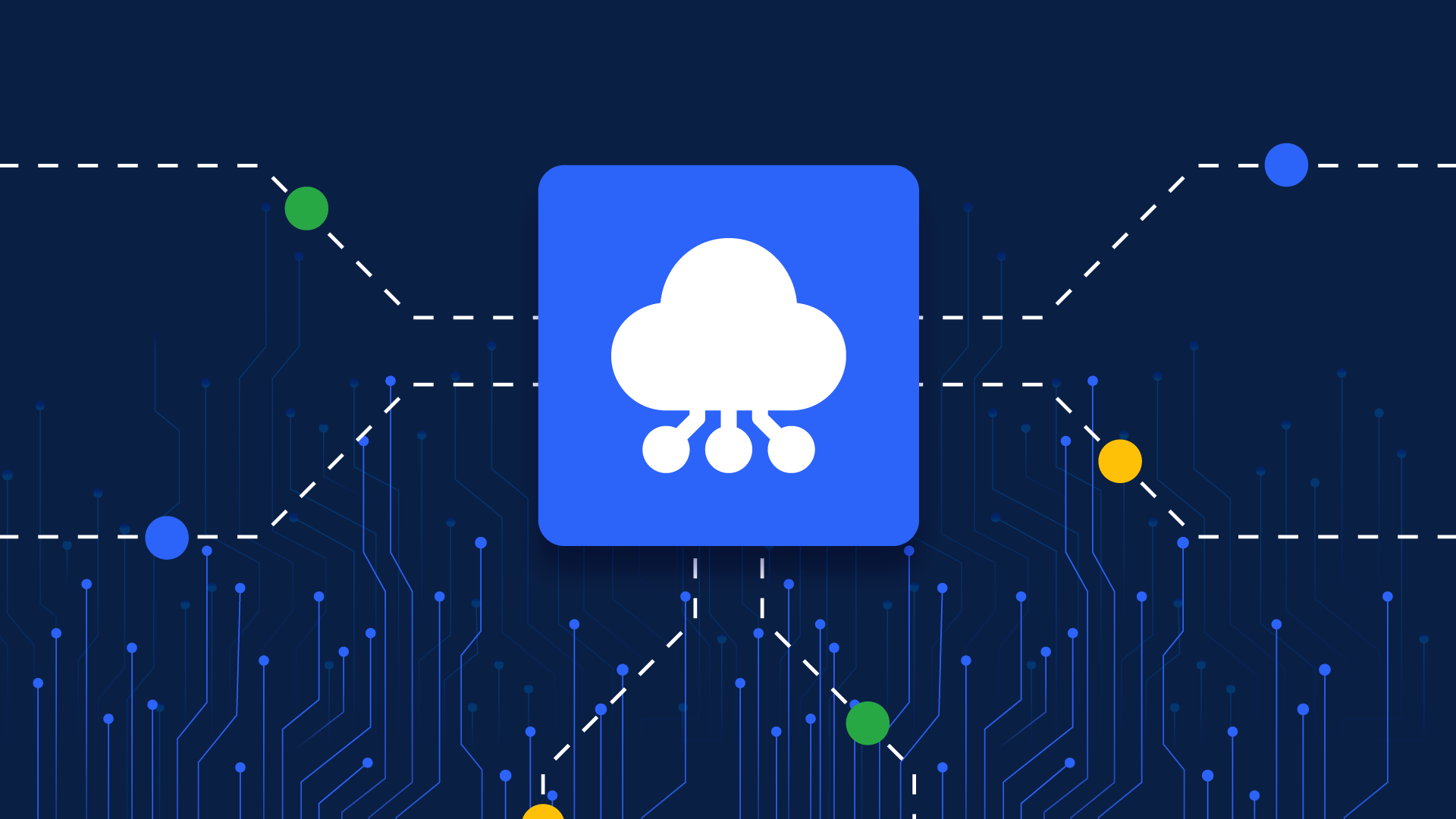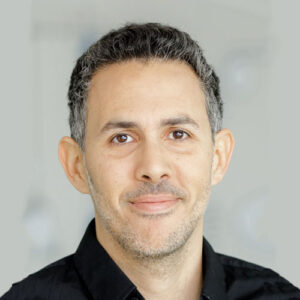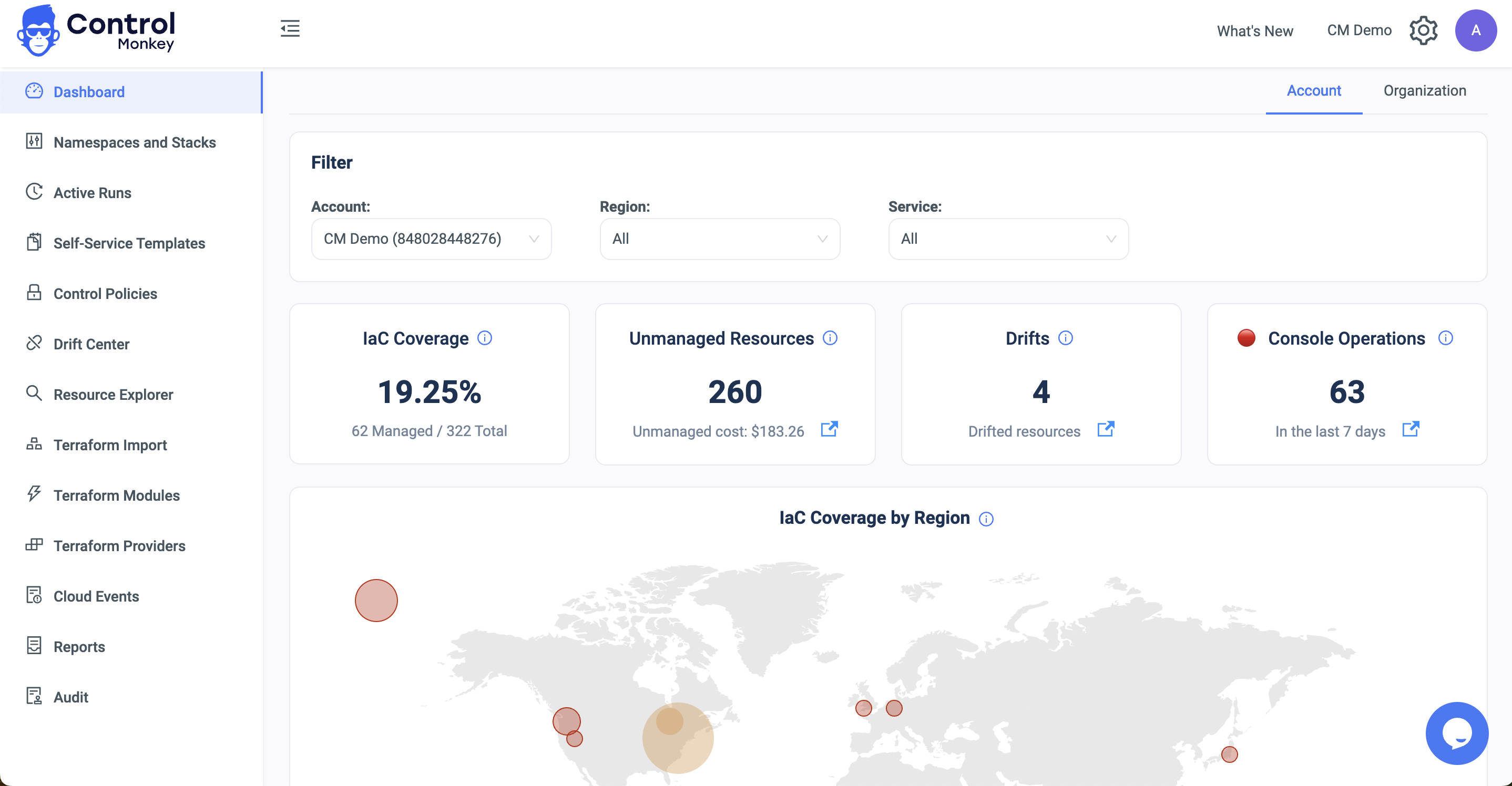Driving DevOps career growth, skills development and cloud governance
Are you a DevOps engineer today and you are looking to move up? Do you want to transition from building CI/CD pipelines to leading DevOps strategy, optimizing cloud governance, and making high-impact business decisions?
The role of a DevOps Director is much more than just automation. It is about scaling teams, enforcing cloud governance, reducing costs, aligning DevOps with business goals and accelerating time to market. And the demand for skilled DevOps leaders has never been higher.
- Companies are actively seeking DevOps Directors who can bridge the gap between engineering and business.
- Cloud governance is now a priority – ensuring compliance, optimizing cloud spend, and mitigating risk.
- Leadership skills are critical – technical skill alone is not enough.
In this blog, we’ll walk you through a possible DevOps career path, from DevOps Engineer to DevOps Director, covering the technical competence, business knowledge, and leadership skills you might need to become a DevOps Director.
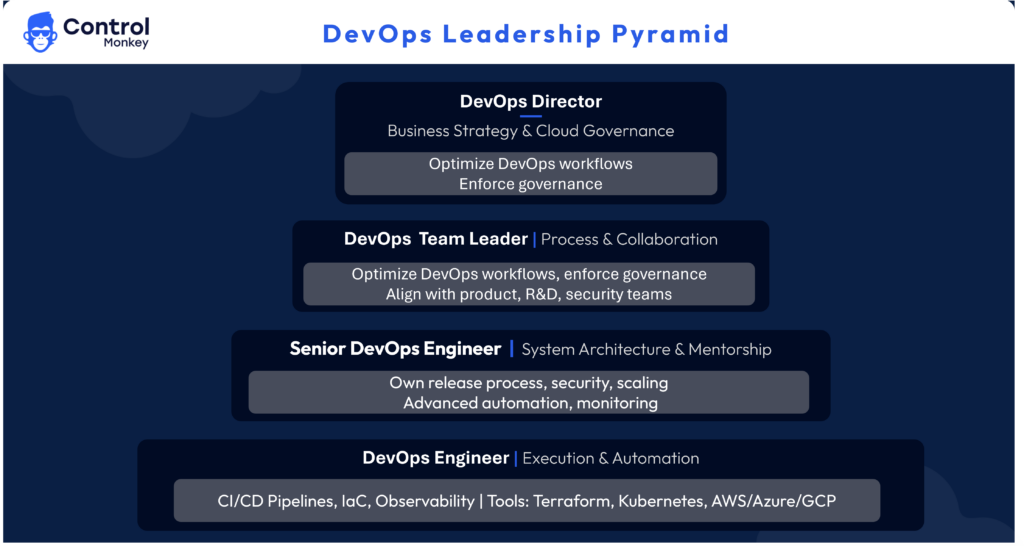
Ready to Move Up? Your Path to Becoming a DevOps Director
The path from DevOps Engineer to DevOps Director is not just about technical know-how – it’s about growing as a leader, mastering cloud governance, and aligning DevOps with business goals. Here’s how your role evolves at each stage of the career ladder.
DevOps Engineer: Building a Strong Technical Foundation
As a DevOps engineer, you’ll have a broad level of technical knowledge around Cloud. Your focus is on delivering reliable, scalable, and secure systems You may have deeper knowledge and be certified with either AWS, Azure or Google Cloud. You understand how to:
- Build, deliver and run applications in the cloud and cloud governance.
- Use IaC, Kubernetes and automation tools such as Terraform.
- Build CI/CD pipelines, observability, application performance monitoring.
- Implement security practices, scan code and undertake pen testing.
As you master these skills, you’ll start taking on more responsibility and thinking beyond execution.
Senior DevOps Engineer: Expanding Ownership & Leadership
As you move to Senior DevOps Engineer, your scope of the work changes as you start to manage and own the release process and build the entire pipeline. Your focus shifts from taking on individual tasks to managing the bigger picture. You now:
- Structure your systems architecturally and integrate applications across the SDLC.
- Make decisions on when to deliver and how to deliver.
- Read the evolving technology landscape and identify relevant new trends.
- Mentor junior engineers as you start to develop towards technical leadership.
DevOps Manager: Leading People, Process, and Strategy
Now, you’re responsible for structuring teams, optimizing processes, and driving efficiency. A DevOps Manager focuses heavily on:
- Process, collaboration and how teams are structured – Collaboration across departments working closely with R&D, security, and product teams.
- Business acumen and experience to build your DevOps vision and strategy – Shifting focus from technical problems to business alignment
- Working collaboratively with R&D, product development and security.
- How DevOps relates to cost reduction programs and business growth.
- Soft skills gain importance over simply resolving technical issues.
DevOps Director: Owning Strategy, Governance & Business Impact
Becoming a DevOps Director means stepping into a high-level leadership role where your focus is on strategy, governance, and scalability. You are responsible for:
- Leading the overall DevOps vision and strategy, one that will directly impact business outcomes.
- Ensuring infrastructure costs are aligned to business goals, compliance, and scalability while safeguarding time-to-market for releases.
- Optimizing cloud resources to prevent inefficiencies and enforce governance policies that reduce security risks.
- Automating cloud governance – a DevOps Director can deliver a 50% reduction in production tickets and reduce cloud costs as you shut down unused resources.
- Scale, lead, and direct DevOps team – you are less involved in day-to-day execution.
- A DevOps Director typically possesses at least five years’ deep technical expertise with:
- Proficiency in DevOps tools and practices, including CI/CD pipelines, containerization (Docker, Kubernetes), and cloud platforms (AWS, Azure, Google Cloud).
- Strong programming skills in languages like Python, Java, or Bash.
- Certifications like AWS Certified DevOps Engineer, Microsoft Azure DevOps Engineer Expert, or Kubernetes Administrator and DevOps-specific certifications, such as the BCS Foundation Level Certificate in DevOps
A DevOps Director is no longer just a technical expert – they are a business leader who drives efficiency, governance, and cost optimization across the organization.
Challenges Facing New DevOps Directors Moving Into Leadership
Delivering value to the customer while keeping a firm handle on the management of operational costs is a tough balancing act. With growing pressure on cloud governance and increasing regulatory requirements, it is even harder to control costs and meet strategic SLAs and KPIs. To get a handle on how you will be measured and monitored in your new role, here are some of the common KPIs applied to Senior DevOps, DevOps Managers and DevOps Directors:
- Deployment frequency.
- Lead time to production.
- Change failure rate.
- Mean time to repair (MTTR).
- Percentage of services with full observability.
- Percentage of delivery pipelines fully automated.
- Cloud spend versus budget.
Pro Tip: You should use DORA metrics as your north star with the guiding principles of: deliver fast, deliver quality, and augment these metrics with financial (cost per environment) and operational (incident rates, MTTR) metrics. Importantly, you must review metrics monthly with your leadership team.
Four Key Steps for Aspiring DevOps Directors to Start to Think and Plan in ‘Business Terms’
To move from tactical technical day-to-day execution to strategic leadership is a process and you need to think like a business leader. Here are four key shifts every aspiring DevOps Director should make:
Aspiring DevOps Directors should follow these four steps to start to develop more broadly:
1. Understand the business
- It sounds simple, but learn how the company makes money.
- Align your DevOps goals to the business goals, such as faster deployment cycles and releases, lower incident rates, reduced cloud spend.
- Enable cloud cost savings by reducing drift and enforcing compliance to lower spend.
- Understand how DevOps impacts cost reduction, efficiency, cloud governance, and revenue growth.
2. Speak in metrics executives care about
- Executives care about revenue, customer satisfaction, and cost
- Translate DevOps work into these outcomes
3. Co-create goals with product and engineering
- Don’t build a roadmap in isolation — collaborate with all the different teams: product, R&D, and security.
4. Use data-driven reporting
- As mentioned earlier, use DORA metrics to support claims
- Augment with financial and operational metrics
What Soft Skills Will You Need to Lead a DevOps Team?
Technical skills are critical as you move up, but these must be balanced with strong leadership and communication skills and cross-team collaboration. You also need essential soft skills that include:
- Empathy and active listening
- DevOps bridges multiple teams including developers, operations, security, and products. You need to take time to understand their pain points and craft solutions accordingly.
- Influence without authority
- DevOps’ success comes from influencing other teams.
- You rarely ‘own’ the code being deployed. You therefore need to convince and persuade but not demand.
- Conflict resolution
- DevOps touches sensitive areas — production access, deployment rights, security gates.
- Handling conflicts between speed to market and safety/security is critical.
- Strategic thinking
- You can’t just fight fires — you need to step back and design systems and processes that prevent those fires in the first place.
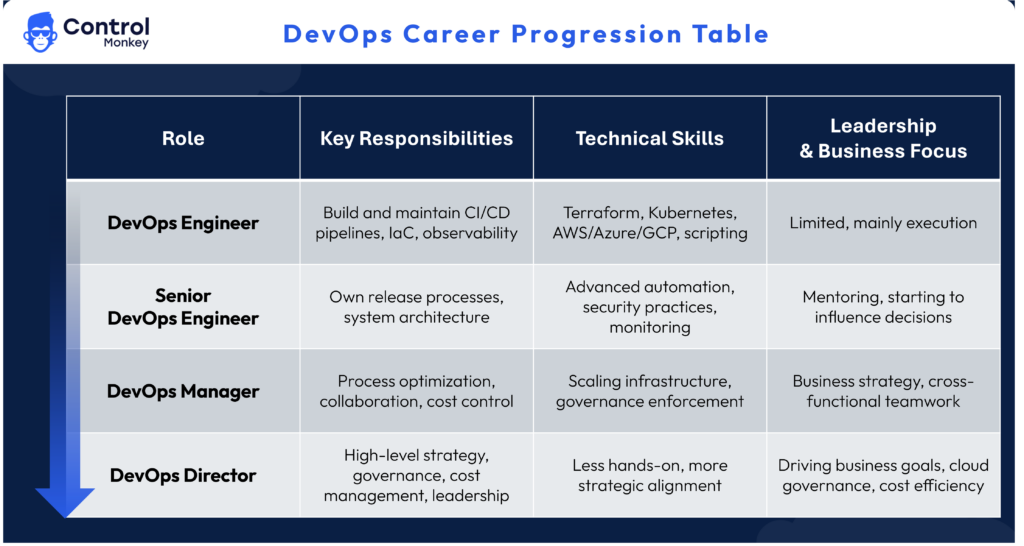
How DevOps Directors Can Scale High-Performing Teams

These were provided by Mark Mishaev, Director, Head of Engineering at Checkmarx.
Mark is a highly professional engineer and software architect, extremely proficient and knowledgeable in multiple domains.
- Define ownership and scope clearly
-
-
- Know where DevOps ends, and platform engineering starts
- Identify who owns observability — DevOps or the teams?
-
- Hire the right talent
-
-
- DevOps is not a ‘jack-of-all-trades’ role
- You need a mix of pipeline engineers, infrastructure experts, observability specialists, and platform builders.
-
- Avoid becoming a ticket factory
-
-
- DevOps can be viewed as a ‘service team’ handling deployments.
- Mature teams build self-service, so DevOps focuses on enabling rather than executing.
-
- Balance standardization versus flexibility
-
- Do you enforce one golden pipeline for all? Or allow flexibility per team?
- Scaling means balancing this tension — standards reduce cognitive load, but too much rigidity kills innovation.
Put Yourself on the Right Career Path with ControlMonkey
ControlMonkey helps DevOps teams scale automation, enforce cloud governance, and eliminate hidden infrastructure risks. With ControlMonkey DevOps can implement a proactive DevOps strategy, reduce mundane manual work, achieve operational excellence and progress to become a DevOps Director.







